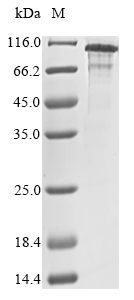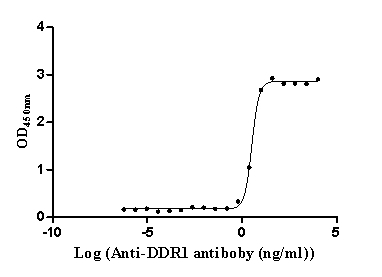Recombinant Human SUMO-activating enzyme subunit 2 (UBA2)
Unavailable-
货号:CSB-EP890664HU
-
规格:¥1536
-
图片:
-
其他:
产品详情
-
纯度:Greater than 85% as determined by SDS-PAGE.
-
基因名:
-
Uniprot No.:
-
别名:Anthracycline associated resistance ARX; Anthracycline-associated resistance ARX; ARX; FLJ13058; HRIHFB2115; SAE 2; SAE2; SAE2_HUMAN; SUMO 1 activating enzyme subunit 2; SUMO activating enzyme subunit 2; SUMO-activating enzyme subunit 2; UBA2; UBA2 ubiquitin activating enzyme E1 homolog; Ubiquitin like 1 activating enzyme E1B; Ubiquitin like modifier activating enzyme 2; Ubiquitin-like 1-activating enzyme E1B; UBLE1B
-
种属:Homo sapiens (Human)
-
蛋白长度:Full Length
-
来源:E.coli
-
分子量:84.2 kDa
-
表达区域:1-640aa
-
氨基酸序列MALSRGLPRELAEAVAGGRVLVVGAGGIGCELLKNLVLTGFSHIDLIDLDTIDVSNLNRQFLFQKKHVGRSKAQVAKESVLQFYPKANIVAYHDSIMNPDYNVEFFRQFILVMNALDNRAARNHVNRMCLAADVPLIESGTAGYLGQVTTIKKGVTECYECHPKPTQRTFPGCTIRNTPSEPIHCIVWAKYLFNQLFGEEDADQEVSPDRADPEAAWEPTEAEARARASNEDGDIKRISTKEWAKSTGYDPVKLFTKLFKDDIRYLLTMDKLWRKRKPPVPLDWAEVQSQGEETNASDQQNEPQLGLKDQQVLDVKSYARLFSKSIETLRVHLAEKGDGAELIWDKDDPSAMDFVTSAANLRMHIFSMNMKSRFDIKSMAGNIIPAIATTNAVIAGLIVLEGLKILSGKIDQCRTIFLNKQPNPRKKLLVPCALDPPNPNCYVCASKPEVTVRLNVHKVTVLTLQDKIVKEKFAMVAPDVQIEDGKGTILISSEEGETEANNHKKLSEFGIRNGSRLQADDFLQDYTLLINILHSEDLGKDVEFEVVGDAPEKVGPKQAEDAAKSITNGSDDGAQPSTSTAQEQDDVLIVDSDEEDSSNNADVSEEERSRKRKLDEKENLSAKRSRIEQKEELDDVIALD
Note: The complete sequence including tag sequence, target protein sequence and linker sequence could be provided upon request. -
蛋白标签:N-terminal 6xHis-SUMO-tagged
-
产品提供形式:Liquid or Lyophilized powder
Note: We will preferentially ship the format that we have in stock, however, if you have any special requirement for the format, please remark your requirement when placing the order, we will prepare according to your demand. -
缓冲液:Tris-based buffer,50% glycerol
-
储存条件:Store at -20°C/-80°C upon receipt, aliquoting is necessary for mutiple use. Avoid repeated freeze-thaw cycles.
-
保质期:The shelf life is related to many factors, storage state, buffer ingredients, storage temperature and the stability of the protein itself.
Generally, the shelf life of liquid form is 6 months at -20°C/-80°C. The shelf life of lyophilized form is 12 months at -20°C/-80°C. -
货期:Basically, we can dispatch the products out in 1-3 working days after receiving your orders. Delivery time may differ from different purchasing way or location, please kindly consult your local distributors for specific delivery time.Note: All of our proteins are default shipped with normal blue ice packs, if you request to ship with dry ice, please communicate with us in advance and extra fees will be charged.
-
注意事项:Repeated freezing and thawing is not recommended. Store working aliquots at 4°C for up to one week.
-
Datasheet & COA:Please contact us to get it.
相关产品
靶点详情
-
功能:The heterodimer acts as an E1 ligase for SUMO1, SUMO2, SUMO3, and probably SUMO4. It mediates ATP-dependent activation of SUMO proteins followed by formation of a thioester bond between a SUMO protein and a conserved active site cysteine residue on UBA2/SAE2.
-
基因功能参考文献:
- Calcium/calpain-induced cleavage of the SAE2 leads to sumoylation inhibition reslting in bacillary dysentery. PMID: 29231810
- We propose that disturbance of the SUMOylation pathway, mediated by pathogenic variants in UBA2, is a novel mechanism for aplasia cutis congenita and other phenotypic abnormalities. PMID: 28110515
- Here, we show that hHR23A utilizes both the UBA2 and XPCB domains to form a stable complex with Vpr, linking Vpr directly to cellular DNA repair pathways and their probable exploitation by the virus. PMID: 24318982
- This study has identified the mechanism used to localize SAE to the nucleus. PMID: 23095757
- Data indicate the role of anti-SUMO activating enzyme SAE1 and SAE2 antibody as marker of dermatomyositis. PMID: 22884621
- Data show that the SAE2 subunit of the small ubiquitin-like modifier (SUMO) E1 is autoSUMOylated at residue Lys-236, and SUMOylation was catalyzed by Ubc9 at several additional Lys residues surrounding the catalytic Cys-173 of SAE2. PMID: 22403398
- loss of SAE1/2 activity drives synthetic lethality with Myc; inactivation of SAE2 leads to mitotic catastrophe and cell death upon Myc hyperactivation; findings in Myc-high breast cancers suggest low tumor SAE1 and SAE2 correlates metastasis-free survival PMID: 22157079
- The mammalian E1 subunits can be imported separately, identify nuclear localization signals (NLSs) in Aos1 and in Uba2, and demonstrate that their import is mediated by importin alpha/beta in vitro and in intact cells. PMID: 21209321
- structures of heterodimeric Sae1/Sae2-Mg.ATP and Sae1/Sae2-SUMO-1-Mg.ATP complexes PMID: 15660128
- UBA2 stabilizes APOBEC3G by preventing ubiquitin chain elongation and proteasome-mediated proteolysis. PMID: 18680593
显示更多
收起更多
-
亚细胞定位:Cytoplasm. Nucleus. Note=Shuttles between the cytoplasm and the nucleus, sumoylation is required either for nuclear translocation or nuclear retention.
-
蛋白家族:Ubiquitin-activating E1 family
-
数据库链接:
HGNC: 30661
OMIM: 613295
KEGG: hsa:10054
STRING: 9606.ENSP00000246548
UniGene: Hs.631580
Most popular with customers
-
Recombinant Human Prolactin receptor (PRLR), partial (Active)
Express system: Mammalian cell
Species: Homo sapiens (Human)
-
Recombinant Rat Intestinal-type alkaline phosphatase 1 (Alpi) (Active)
Express system: Mammalian cell
Species: Rattus norvegicus (Rat)
-
Express system: Mammalian cell
Species: Homo sapiens (Human)
-
Recombinant Human Epithelial discoidin domain-containing receptor 1 (DDR1), partial (Active)
Express system: Mammalian cell
Species: Homo sapiens (Human)
-
Recombinant Human Dickkopf-related protein 1 (DKK1) (Active)
Express system: Mammalian cell
Species: Homo sapiens (Human)
-
Recombinant Human Early activation antigen CD69 (CD69), partial (Active)
Express system: Mammalian cell
Species: Homo sapiens (Human)
-
Recombinant Human CD81 antigen (CD81), partial (Active)
Express system: Mammalian cell
Species: Homo sapiens (Human)
-
Recombinant Human Carcinoembryonic antigen-related cell adhesion molecule 8(CEACAM8) (Active)
Express system: Mammalian cell
Species: Homo sapiens (Human)







-AC1.jpg)













